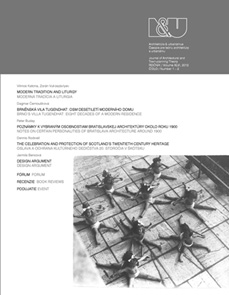DESIGN ARGUMENT
DESIGN ARGUMENT
Author(s): Jarmila BencováSubject(s): Cultural Essay, Political Essay, Societal Essay
Published by: Historický ústav SAV, v. v. i.
Keywords: methodology; idea; phenomenon; design; terminology; meaning; disegno
Summary/Abstract: The present text is a continual reaction to the increasingly free understanding of the idea of “design” and its justification. Design and its reflections are faced with a wide range of methodological problems, ensuing from the essential character of the subject of discussion, which is not helped in the least by linguistic codification. The English phrase “design” entered into Slovakia through the subsequent transcription in the phonetic adaptation of “dizajn”, yet here none of the associated meanings to the concept allow for a better identification either of its contents or of its principles and applications to the situation in the area of culture, science or art. Investigation of the problem of the emergence of the original concept of design, the formulation of its intriguing history and the spectrum of inspirational meanings will allow us to find a possible level of interpretation and an argumentative key to its current problematic status. Investigation of the forms and contents given to the word “design” is, in turn, an essential reason behind the decision to leave it in its English spelling, indicated here by italics. At present, the idea of design finds itself in a position of characterising the phenomenon for the 21st century (Wolfgang Welsch), yet at the same time in the role of obscuring the basic idea. As it now stands, the theme continues to provoke argument: is design really what designers or architects create (design?) or is it what they use for working (for designing?). On one side, the functionalist-oriented critique of design argues against the idea of redesign, where the problem is what level of originality design may literally allow itself when it largely is restricted to the new “clothing” of previously invented functional objects (Jean Baudrillard). In other words, here primacy is assigned to the designing activity over the reality of the product. Yet, considering how much of today’s material reality is made real precisely through the means of information, it has become necessary to link the real to the apparent, and to count on the two concepts intersecting. On the other side of the discussion, the question has emerged as to where, and into what professions, the activity of the designer can reach that encompasses the subject of “product-design” or the “design-object”. Here, the outcome need not be simply a product with certain functional and aesthetic qualities, but practically anything. In another of the theoretical and philosophical aspects of contemporary reflections on design, there are its various associated meanings and connotations according to the English definition of the verb “to design”: – to sketch, determine, to reflect, or the noun – sketch, pattern, outline, intention, plan, proposal; or: intrigue, conspiracy. From this point, it becomes possible to create an even longer chain of ideas, such as the “designing of designed design” or design of design etc., because the word would indicate nearly all crucial ...
Journal: Architektúra & Urbanizmus
- Issue Year: 46/2012
- Issue No: 1-2
- Page Range: 96 - 109
- Page Count: 14
- Language: Slovak

